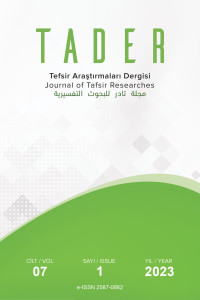Tâbiîn Döneminde Kur’ân Tefsiri -Nâfi‘ Mevlâ İbn Ömer Örneği, Yazar Yunus Emre Gördük (İstanbul: Siyer Yayınları, 2017), 382 Sayfa, ISBN: 6059283950
Abstract
Rivâyet tefsirlerinin olmazsa olmazlarından biri de tâbiîn kavlidir. Bu tefsirlere tâbiîlerin katkısı son derece fazladır. Kabul edilip edilmemesi bir yana âlimlerin çoğu tâbiîn tefsirini eserlerinde kaynak olarak göstermektedir. Tanıtımını yaptığımız “Tâbiîn Döneminde Kur’ân Tefsiri -Nâfi‘ Mevlâ İbn Ömer Örneği” adlı kitabın yazarı olan Yunus Emre Gördük’ü bu eseri yazmaya yönlendiren şey de henüz doktora ders dönemindeyken hocasının Mevâlî tâbiîlerin Kur’ân’ın anlaşılmasına dair katkılarının incelenmesi gerektiğini belirtmesidir. Yazarın titiz çalışmaları sonucu eser yaklaşık on sene sonra ilk baskısıyla yayımlanmıştır. Yazarın da ifade ettiği gibi Aydemir’in “Rivâyetlerin Olasılığı Teorisi Işığında Nâfi‘ Mevlâ İbn Ömer” isimli çalışma dışında Nâfi‘ Mevlâ İbn Ömer ile ilgili yazılan özgün bir esere rastlanmamıştır. Aydemir, eserini hadis alanı çerçevesinde inceleyip araştırmışken Gördük Nâfi‘’nin tefsir ilmine katkılarından bahsetmiştir. Yazar birinci bölümde “Nâfi‘’nin Şahsî Hayatı ve İlmî Cephesi” başlığının altında Nâfi‘’nin hayatına, hocalarına ve öğrencilerine değindikten sonra kitabın ana hedefinin bahsedildiği ikinci bölümde ise “Nâfi‘nin Rivâyetleri ve Tefsir Literatürüne Etkisi” başlığı altında Nâfi‘’nin tefsirle ilişkili rivâyetlerine yer vererek genel değerlendirmelerde bulunur. Yazar rivâyetleri incelerken tefsir kitaplarındaki Nâfi‘ lafzının geçtiği her satırı incelediğini belirtir. Ayrıca Nâfi‘’nin rivâyetlerine yer verirken isnâdın tamamını zikrederek rivâyetlerin güvenirliliğine de dikkat çeker. Bu bağlamda eserin yazarın titiz çalışmalarıyla telif edildiğini ve tefsirin Nafi‘ özelinde mevâlî tâbiîler ile şekillendiği söylemek kaçınılmazdır.
Thanks
Hayırlı çalışmalar dilerim
Abstract
The Exegesis of the Qur’an in the Tâbiîn Period -Nâfi‘ Mevlâ İbn Ömer Example, author Yunus Emre Gorduk (Istanbul: Siyer Publications, 2017), 382 Page, ISBN: 6059283950
Abstract
One of the sine qua non of the narration tafsir is the qawli of the tâbiîn. The contribution of the tâbiîn to these tafsirs is extremely high. Regardless of whether it is accepted or not, most of the scholars refer to the tafsir of the tâbiîn as a source in their works. The thing that prompted Yunus Emre Gördük, the author of the book entitled “The Exegesis of the Qur’an in the Tâbiîn Period -Nâfi‘ Mevlâ İbn Ömer Example”, which we have introduced, to write this work, is that his teacher stated that the contributions of the Mevâlî tâbiîn to the understanding of the Qur’an should be examined while he was still in his doctoral course. As a result of the author’s meticulous work, the work was published in its first edition approximately ten years later. As the author has stated, in the light of Aydemir’s Theory of Probability of Narrations, no original work has been found about Nâfi‘ Mevlâ İbn Ömer, except for the work named Nâfi‘ Mevlâ İbn Ömer. Aydemir, while examining and researching his work within the framework of hadith, talked about Gördük Nâfi‘s contributions to the science of tafsir. In the first part, under the title of “Nâfi‘s Personal Life and Scientific Front”, the author mentions Nâfi‘s life, his teachers and students, and in the second part, where the main goal of the book is mentioned, under the title of “Nâfi‘s Narrations and Its Effect on Tafsir Literature”, Nâfi‘s narrations related to tafsir are discussed and makes general evaluations. While examining the narrations, the author states that he examined every line in which the word Nâfi‘ in the tafsir books is mentioned. In addition, while giving the narrations of Nâfi‘, he mentions the entire isnad and draws attention to the reliability of the narrations. In this context, it is inevitable to say that the work was copyrighted by the author’s meticulous work and that the tafsir was shaped by mevâlî tabiîn in particular Nâfi‘.
Details
| Primary Language | Turkish |
|---|---|
| Subjects | Religious Studies |
| Journal Section | KİTAP DEĞERLENDİRMESİ |
| Authors | |
| Publication Date | April 30, 2023 |
| Submission Date | December 8, 2022 |
| Acceptance Date | April 27, 2023 |
| Published in Issue | Year 2023 Volume: 7 Issue: 1 |


